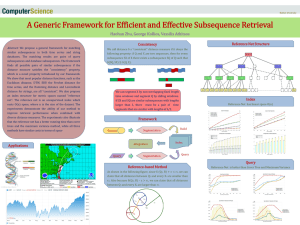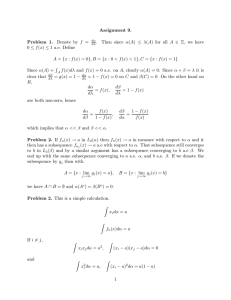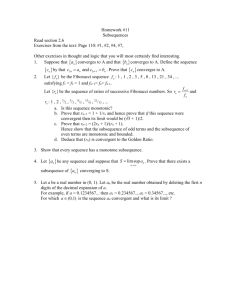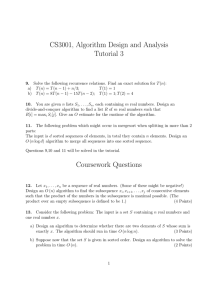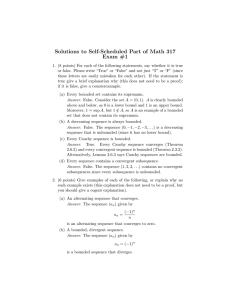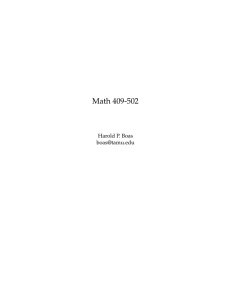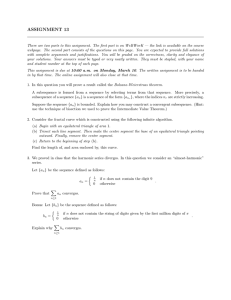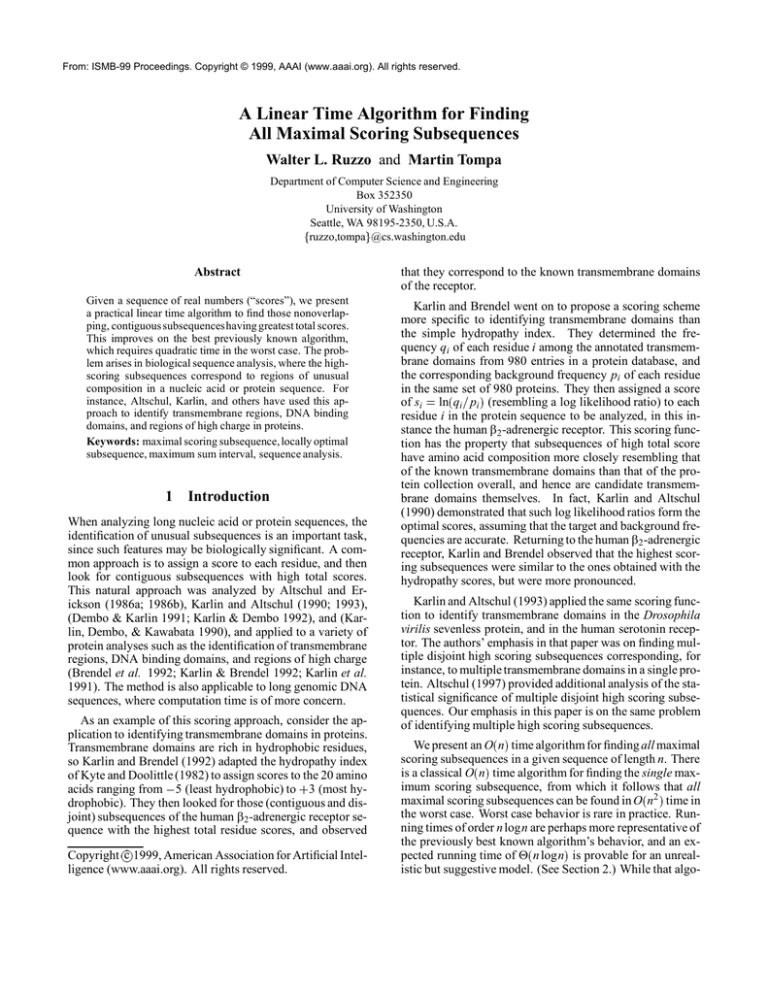
From: ISMB-99 Proceedings. Copyright © 1999, AAAI (www.aaai.org). All rights reserved.
A Linear Time Algorithm for Finding
All Maximal Scoring Subsequences
Walter L. Ruzzo and Martin Tompa
Department of Computer Science and Engineering
Box 352350
University of Washington
Seattle, WA 98195-2350, U.S.A.
fruzzo,tompag@cs.washington.edu
Abstract
that they correspond to the known transmembrane domains
of the receptor.
Given a sequence of real numbers (“scores”), we present
a practical linear time algorithm to find those nonoverlapping, contiguous subsequenceshaving greatest total scores.
This improves on the best previously known algorithm,
which requires quadratic time in the worst case. The problem arises in biological sequence analysis, where the highscoring subsequences correspond to regions of unusual
composition in a nucleic acid or protein sequence. For
instance, Altschul, Karlin, and others have used this approach to identify transmembrane regions, DNA binding
domains, and regions of high charge in proteins.
Keywords: maximal scoring subsequence, locally optimal
subsequence, maximum sum interval, sequence analysis.
Karlin and Brendel went on to propose a scoring scheme
more specific to identifying transmembrane domains than
the simple hydropathy index. They determined the frequency qi of each residue i among the annotated transmembrane domains from 980 entries in a protein database, and
the corresponding background frequency pi of each residue
in the same set of 980 proteins. They then assigned a score
of si = ln(qi = pi ) (resembling a log likelihood ratio) to each
residue i in the protein sequence to be analyzed, in this instance the human β2 -adrenergic receptor. This scoring function has the property that subsequences of high total score
have amino acid composition more closely resembling that
of the known transmembrane domains than that of the protein collection overall, and hence are candidate transmembrane domains themselves. In fact, Karlin and Altschul
(1990) demonstrated that such log likelihood ratios form the
optimal scores, assuming that the target and background frequencies are accurate. Returning to the human β2 -adrenergic
receptor, Karlin and Brendel observed that the highest scoring subsequences were similar to the ones obtained with the
hydropathy scores, but were more pronounced.
1
Introduction
When analyzing long nucleic acid or protein sequences, the
identification of unusual subsequences is an important task,
since such features may be biologically significant. A common approach is to assign a score to each residue, and then
look for contiguous subsequences with high total scores.
This natural approach was analyzed by Altschul and Erickson (1986a; 1986b), Karlin and Altschul (1990; 1993),
(Dembo & Karlin 1991; Karlin & Dembo 1992), and (Karlin, Dembo, & Kawabata 1990), and applied to a variety of
protein analyses such as the identification of transmembrane
regions, DNA binding domains, and regions of high charge
(Brendel et al. 1992; Karlin & Brendel 1992; Karlin et al.
1991). The method is also applicable to long genomic DNA
sequences, where computation time is of more concern.
As an example of this scoring approach, consider the application to identifying transmembrane domains in proteins.
Transmembrane domains are rich in hydrophobic residues,
so Karlin and Brendel (1992) adapted the hydropathy index
of Kyte and Doolittle (1982) to assign scores to the 20 amino
acids ranging from ,5 (least hydrophobic) to +3 (most hydrophobic). They then looked for those (contiguous and disjoint) subsequences of the human β2 -adrenergic receptor sequence with the highest total residue scores, and observed
c 1999, American Association for Artificial IntelCopyright ligence (www.aaai.org). All rights reserved.
Karlin and Altschul (1993) applied the same scoring function to identify transmembrane domains in the Drosophila
virilis sevenless protein, and in the human serotonin receptor. The authors’ emphasis in that paper was on finding multiple disjoint high scoring subsequences corresponding, for
instance, to multiple transmembrane domains in a single protein. Altschul (1997) provided additional analysis of the statistical significance of multiple disjoint high scoring subsequences. Our emphasis in this paper is on the same problem
of identifying multiple high scoring subsequences.
We present an O(n) time algorithm for finding all maximal
scoring subsequences in a given sequence of length n. There
is a classical O(n) time algorithm for finding the single maximum scoring subsequence, from which it follows that all
maximal scoring subsequences can be found in O(n2 ) time in
the worst case. Worst case behavior is rare in practice. Running times of order n logn are perhaps more representative of
the previously best known algorithm’s behavior, and an expected running time of Θ(n logn) is provable for an unrealistic but suggestive model. (See Section 2.) While that algo-
rithm may be fast enough to be useful in practice, ours is an
order of magnitude faster on problems of realistic size. Furthermore, it is not substantially more complex, and presents
some interesting subtleties in its design and analysis. Finally,
we hope better understanding of this problem will lead to improvements in performance of algorithms for more complex
scoring schemes (P. Green (1997)), alternative definitions of
maximal or optimal subsequences (Sellers (1984)), or for
finding certain kinds of maximal subalignments (Altschul
and Erickson (1986a; 1986b), Sellers (1984), Waterman and
Eggert (1987)), for which the best known algorithms are
quadratic or worse. Note that our algorithm immediately
gives a quadratic method quite different from the usual dynamic programming methods for finding maximal (gapless)
subalignments; perhaps further improvements are possible.
Section 2 defines the computational problem to be solved,
and describes the best previously known algorithm for it.
Section 3 provides an alternative characterization of the
problem, and gives some basic facts about maximal scoring subsequences. Section 4 presents our algorithm, and discusses its correctness and analysis. Section 5 outlines some
experimental results.
2
Problem Definition and Previously Known
Algorithms
Problem Definition. The input is a sequence (x1 ; x2 ; : : :; xn )
of (not necessarily positive) real numbers, called “scores.”
The goal is to identify those contiguous subsequences having the greatest total scores, where the score Si j of a subsequence (xi ; xi+1; : : :; x j ) is simply the sum of its elements:
;
Si
;
j=
∑
ik j
xk :
Throughout the paper, the term “subsequence” will be
taken to mean “contiguous subsequence”, and likewise for
“supersequence”. Contiguous subsequences are sometimes
called substrings, segments, intervals, or regions. Likewise,
maximal scoring subsequences (defined below) are sometimes called locally optimal subsequences or maximum sum
intervals.
There is a subtlety in defining exactly what constitutes a
maximal scoring subsequence. Temporarily setting aside the
handling of tied scores, the highest scoring subsequence is
simply the subsequence (xi ; xi+1; : : :; x j ) that maximizes Si j .
It is not so clear, however, what the second best subsequence
should be. The subsequence with the second highest numerical score very likely will overlap the highest scoring subsequence except for the addition or deletion of a few scores at
one end. Given the motivating application, this conveys no
useful information. Instead, the kth best subsequence will be
defined to be the one that maximizes Si j among those subsequences disjoint from the k , 1 best subsequences. Additionally, to avoid trivialities, we stop the process when
the next best score is nonpositive. Returning to the matter of tied scores, a zero-scoring subsequence adjacent to a
positive-scoring one creates overlapping subsequences with
;
;
tied scores. We resolve these ties by disallowing nonempty,
zero-scoring prefixes or suffixes in maximal scoring subsequences.
We define a maximal scoring subsequence (or maximal
subsequence for short) to be any of the (positive scoring)
subsequences found by the process described in the previous paragraph, and the desired output is a list of all these
subsequences. In practice, of course, scores below a certain
threshold might be discarded. Karlin and Altschul (1993) describe how such a threshold should be chosen to correspond
to a desired level of statistical significance.
As an example, consider the input sequence
,5; 3; ,3; 1; 2; ,2; 2; ,2; 1; 5). The highest scoring
subsequence is M = (1; 2; ,2; 2; ,2; 1; 5), with a total score
of 7. (There is another subsequence tied for this score by
appending (3; ,3) to the left end of M, but this subsequence
is not maximal, since it has a nonempty zero-scoring prefix.)
Thus, the maximal subsequences are (4), (3), and M.
(4;
Previously Known Algorithm. Although the definition of the single highest scoring subsequence suggests that
quadratic time would be needed to search over all combinations of i and j, there is a well known linear time algorithm for finding the single maximum scoring subsequence;
cf. Bates and Constable (1985), Bentley (1986, Column 7),
or Manber (1989, Section 5.8). (It can also be found by a
specialization of the Smith-Waterman algorithm (Smith &
Waterman 1981).) The disjointness property immediately
suggests a simple divide-and-conquer algorithm for finding
all maximal subsequences: find the highest scoring subsequence, remove it, and then apply the algorithm recursively
to the remainder of the sequence to the left of the removed
portion, and then to the remainder to the right.
Analysis of this algorithm is similar to that for Quicksort. (For an analysis of Quicksort see, for example, Manber (1989).) In the worst case, it will require quadratic time,
since the next highest scoring subsequence may be a short
subsequence near one end of the remaining sequence in every recursive call. However, if the input is appropriately
random, the expected running time will be Θ(n logn), since
the highest scoring subsequence will usually fall nearer to
the middle. This result holds if (i) the residues in the sequence are chosen independently at random, and (ii) the expected score of a single random residue is negative. Assumption (ii) is a reasonable one (Karlin & Altschul 1990;
1993). Note in particular that if the expected score were positive, then the highest scoring subsequence would likely include most of the sequence, an uninteresting situation. Moreover, if log likelihood ratios are used as scores, as described
in Section 1, then the expected score is the negative of a relative entropy, and is thus provably nonpositive. However,
assumption (i) is decidedly unreasonable in practice: we are
not interested in regions of unusual composition in random
sequences. Nevertheless, the n logn result is suggestive, and
in accord with the performance observed in practice. (See
Section 5.)
3 Alternative Characterization
The procedural definition of maximal scoring subsequences
presented above, while well motivated, is somewhat difficult to use for many purposes, and a more direct definition is
preferable. Intuitively, the desired subsequences are “maximal” in the sense that they cannot be lengthened or shortened without reducing their scores. This simple intuition,
however, is too simple. For example, in the score sequence
(5; ,4:9; 1; 3), both (5) and (1, 3) are maximal: (5) is the
highest scoring subsequence, and (1, 3) is the highest scoring subsequence disjoint from (5). Under the naive definition suggested above, however, (5) would be the only maximal scoring subsequence: although subsequence (1, 3) has
nearly as high a score, it would be excluded because it can be
extended to form a higher scoring sequence (5; ,4:9; 1; 3),
which in turn can be contracted to form the still higher scoring sequence (5). The following alternative characterization
of the maximal scoring subsequences, due to Green (1997),
corrects this problem.
Proposition 1 Let K be any nonempty score sequence. A
subsequence I is maximal scoring in K if and only if
P1. all proper subsequences of I have lower score, and
P2. no proper supersequence of I contained in K satisfies P1.
For the remainder of the paper, we will take this as the
definition of a maximal scoring subsequence, proving its
equivalence to the original procedural definition at the end
of this section. We first develop a variety of useful consequences of the new definition. For example, we show that
every nonempty prefix and suffix of a maximal scoring subsequence has positive score, and that every subsequence satisfying P1 (and hence every individual positive score) is contained in some maximal scoring subsequence. Some of these
properties are needed for the proof of Proposition 1, and
some for the correctness of the algorithm in Section 4.
Let jKj denote the length of a sequence K.
Lemma 2 Let K be any nonempty score sequence. For
any subsequence I of K the following are equivalent:
1. I satisfies property P1.
2. For 0 i jIj; let Si denote the cumulative total of all
scores in K up to and including the ith score of I. Then S0
is the unique minimum and SjIj is the unique maximum of
the Si ’s.
3. All nonempty prefixes and all nonempty suffixes of I have
positive total score.
Proof: 1 ) 2: If for some 0 i < jIj we have Si SjIj ,
then the proper prefix of I with length i has total score at least
that of I. Similarly, if Si S0 for some 0 < i jIj, then the
length (jIj, i) suffix of I has total score at least that of I.
2 ) 3: The total score of the length i prefix of I is Si , S0 ,
which is positive since S0 is the unique minimum. Similarly,
a suffix will have score SjIj , Si , which is positive since SjIj
is the unique maximum.
3 ) 1: The score of any proper subsequence J of I will be
the total score of I minus the scores of the prefix of I to the
left of J and the suffix of I to the right of J. Since nonempty
prefixes and suffixes all have positive scores, J will have a
2
strictly lower score than I.
Lemma 3 Let K be any nonempty score sequence. The
maximal subsequences of K are pairwise disjoint (neither
overlapping nor abutting).
Proof: Suppose I and J are maximal and nondisjoint, with
I’s left end at least as far left as J’s. Let L be the union of
the intervals I and J. By Lemma 2, the minimum cumulative
scores within I and J occur uniquely at their respective left
ends, and the left end of J falls within (or at the right end of)
I, so the minimum cumulative score within L occurs uniquely
at its left end. Similarly, L’s maximum cumulative score occurs uniquely at its right end. Thus by Lemma 2, L satisfies
property P1, contradicting the P2 property of either I or J. 2
Lemma 4 Let K be any nonempty score sequence. Every
subsequence I of K satisfying property P1 is contained in a
maximal subsequence of K. In particular, every positive single score is contained in a maximal subsequence.
Proof: Suppose not. Let I be a counterexample of maximum length. I satisfies property P1, but is not itself maximal, so it must be properly contained in some supersequence
J satisfying P1. J cannot be contained in any maximal subsequence, for otherwise I would be contained in a maximal
subsequence. Thus J is also a counterexample to the lemma,
contradicting the choice of I as a longest counterexample. 2
Corollary 5 Within any subsequence that does not overlap any maximal subsequence, the cumulative scores are
monotonically nonincreasing.
Lemma 6 Let K be any nonempty score sequence.
Among consecutive occurrences of the minimum (maximum) cumulative total of all scores in any prefix of K, the
rightmost (leftmost, respectively) is either at the left (right,
respectively) end of one of its maximal subsequences, or at
the right (left, respectively) end of K.
Proof: If a minimum cumulative score occurs in a subsequence H that does not overlap any maximal subsequence,
by Corollary 5 the rightmost of consecutive occurrences of
this minimum must occur at the right end of H, which is either the right end of K or the left end of some maximal subsequence. If the minimum cumulative score occurs within
some maximal subsequence, it must occur at its left end, by
Lemma 2. Arguments for the maximum cumulative score are
dual.
2
Suppose J is a subsequence of a score sequence K. The
key issue in our inductive correctness arguments turns out
to be relating the maximal subsequences of J to those of
K. The following three lemmas give some of these relationships. Lemma 7 establishes the easy direction, and Lemmas 8 and 9 give useful partial converses. We sometimes
say that a sequence is I-maximal as a shorthand for “maximal scoring subsequence of I.”
Lemma 7 Let K be any nonempty score sequence. If I is
a subsequence of J, which in turn is a subsequence of K, and
I is K-maximal, then I is J-maximal.
Proof: Since I is K-maximal, it satisfies property P1, and
no proper supersequence of I in K satisfies P1. Then certainly there is no proper supersequence of I in J satisfying
P1.
2
Lemma 8 Let K be any nonempty score sequence. Suppose J is a prefix of K, and suppose all scores in the suffix
of K following J are nonpositive. Then the maximal subsequences of K are exactly the same as those of J.
Proof: If I is K-maximal, then I is J-maximal by
Lemma 7. Conversely, if I is J-maximal, then no proper supersequence of I satisfying property P1 exists in J, and every
supersequence extending outside of J fails to satisfy property
P1 by Lemma 2, since it has a nonempty nonpositive suffix.
2
Thus, I is K-maximal.
4
New Algorithm
We now present an algorithm that finds all maximal scoring
subsequences in time O(n). We first describe the algorithm,
and then discuss its correctness and performance.
Algorithm. The algorithm reads the scores from left
to right, and maintains the cumulative total of the scores
read so far. Additionally, it maintains a certain ordered list
I1 ; I2 ; : : :; Ik,1 of disjoint subsequences. For each such subsequence I j , it records the cumulative total L j of all scores
up to but not including the leftmost score of I j , and the total
R j up to and including the rightmost score of I j .
The list is initially empty. Input scores are processed as
follows. A nonpositive score requires no special processing
when read. A positive score is incorporated into a new subsequence Ik of length one1 that is then integrated into the list
by the following process.
Lemma 9 Let K be any nonempty score sequence. Suppose M is a maximal subsequence of K, and let L and R be the
two (possibly empty) subsequences of K formed by deletion
of M. Then a subsequence I of L is L-maximal if and only if
I is K-maximal. Similarly, a subsequence of R is R-maximal
if and only if it is K-maximal.
1. The list is searched from right to left for the maximum
value of j satisfying L j < Lk .
2. If there is no such j, then add Ik to the end of the list.
3. If there is such a j, and R j Rk , then add Ik to the end of
the list.
4. Otherwise (i.e., there is such a j, but R j < Rk ), extend
the subsequence Ik to the left to encompass everything
up to and including the leftmost score in I j . Delete subsequences I j ; I j +1; : : :; Ik,1 from the list (none of them
is maximal) and reconsider the newly extended subsequence Ik (now renumbered I j ) as in step 1.
Proof: We will only give the argument for L, the argument
for R being identical.
After the end of the input is reached, all subsequences remaining on the list are maximal; output them.
The “if” direction is immediate from Lemma 7.
For the “only if” direction, suppose I is L-maximal but
not K-maximal. I satisfies property P1, so by Lemma 4, I is
contained in some J that is K-maximal. J properly contains
I, since I is not K-maximal. Furthermore, J cannot be contained in L, for otherwise I is not L-maximal. But neither can
J extend past the end of L, because then it would overlap M,
violating disjointness of K-maximal sequences (Lemma 3).
2
Finally we prove Proposition 1, establishing the equivalence of the two alternative definitions of “maximal scoring subsequence” considered above. That is, we show that
a subsequence is maximal according to the original procedural definition given in Section 2 if and only if it satisfies
properties P1 and P2 of Proposition 1.
Proof (of Proposition 1): Let M AX(K) be the complete
list of subsequences satisfying P1 and P2 in K. Any positivescoring subsequence M having a globally maximum score
and no zero-scoring prefix or suffix clearly satisfies properties P1 and P2. Hence, M AX(K) is the empty list if K consists
only of nonpositive scores (by Lemma 2), and otherwise is
hM AX(L); M; M AX(R)i (easily shown by Lemma 9 and induction on jKj), which is exactly the list produced by the recursive algorithm in Section 2.
2
As an example of the execution of the algorithm, consider the sample input from Section 2. After reading the
scores (4; ,5; 3; ,3; 1; 2; ,2; 2), suppose the list of disjoint
subsequences is I1 = (4); I2 = (3); I3 = (1; 2); I4 = (2), with
(L1 ; R1 ) = (0; 4), (L2 ; R2 ) = (,1; 2), (L3 ; R3 ) = (,1; 2), and
(L4 ; R4 ) = (0; 2). (See Figure 1.) At this point, the cumulative score is 2. If the ninth input is ,2, the list of subsequences is unchanged, but the cumulative score becomes
0. If the tenth input is 1, Step 1 produces j = 3, because I3
is the rightmost subsequence with L3 < 0. Now Step 3 applies, since R3 1. Thus I5 = (1) is added to the list with
(L5 ; R5 ) = (0; 1), and the cumulative score becomes 1. If the
eleventh input is 5, Step 1 produces j = 5, and Step 4 applies, replacing I5 by (1; 5) with (L5 ; R5 ) = (0; 6). The algorithm returns to Step 1 without reading further input, this
time producing j = 3. Step 4 again applies, this time merging I3 , I4 , and I5 into a new I3 = (1; 2; ,2; 2; ,2; 1; 5) with
(L3 ; R3 ) = (,1; 6). The algorithm again returns to Step 1,
but this time Step 2 applies. If there are no further input
scores, the complete list of maximal subsequences is then
I1 = (4); I2 = (3); I3 = (1; 2; ,2; 2; ,2; 1; 5), as in Section 2.
Correctness. The key to proving the correctness of the
algorithm is the following lemma.
1 In
practice, one could optimize this slightly by processing a
consecutive series of positive scores as Ik .
4
-5
3
2
-3
111
000
1
000
111
000
111
000
111
000
111
-2 2
-2
Cumulative Score
Cumulative Score
5
5
4
-5
1
3
-3
1
111
000
1
000
111
000
111
000
111
000
111
Sequence Position
-2
-2 2
2
Sequence Position
Figure 1: An example of the algorithm. Bold segments indicate score sequences currently in the algorithm’s list. The left figure
shows the state prior to adding the last three scores, and the right figure shows the state after.
Lemma 10 Let Q be a score sequence. Suppose that a
suffix Ik of Q satisfies property P1. Let P be the prefix of Q
preceding Ik . Further suppose that I1 ; : : :; Ik,1 is the complete ordered list of the P-maximal subsequences. Then the
subsequences I10 ; I20 ; : : : constructed from I1 ; : : :; Ik by Steps 1–
4 above form the complete ordered list of the Q-maximal sequences.
The correctness of the algorithm follows from Lemma 10.
Given an input sequence T, let Qi ; 0 i jT j; be the length
i prefix of T. We show by induction on i that after processing the ith score, the list I1 ; I2; : : : constructed by the algorithm
above is the complete ordered list of Qi -maximal sequences.
The basis, i = 0, is immediate. For the induction step, suppose the list consists of I1 ; : : :; Ik,1 when the ith score is read.
If the ith score is nonpositive, then the maximal subsequences
of Qi are exactly the same as the maximal subsequences of
Qi,1 , by Lemma 8. If the ith score is positive, then it comprises the entire subsequence Ik constructed by the algorithm,
which clearly satisfies property P1. Furthermore, by the induction hypothesis, I1 ; : : :; Ik,1 is the complete ordered list of
the Qi,1 -maximal subsequences, and so Lemma 10 implies
that the algorithm correctly constructs the complete ordered
list of Qi -maximal sequences.
We now prove the Lemma.
Proof (of Lemma 10): There are three cases, paralleling
Steps 2–4 of the algorithm.
C ASE 1: Suppose Step 1 locates no j such that L j < Lk .
Applying Lemma 6 to P and Lemma 2 to Ik , Lk is a minimum
cumulative score in Q. Then applying Lemma 6 to Q and
Lemma 2 to Ik , some prefix J of Ik is Q-maximal. In order
for J to have property P2, J = Ik , so Ik is Q-maximal. The
fact that each I j ; 0 < j < k; is Q-maximal then follows from
Lemma 9, by choosing M = Ik .
C ASE 2: Suppose there is a j such that L j < Lk , and suppose for the greatest such j that R j Rk . We claim that I j is
Q-maximal. Suppose not. From the definition of maximality there must be some proper supersequence J of I j satisfying property P1. Furthermore, this supersequence cannot
lie totally within P (otherwise I j would not be P-maximal).
Consequently, J must overlap Ik . The (nonempty) suffix of
J that begins at the right end of I j must have a nonpositive
score (since Rk , and hence by Lemma 2 every cumulative total within Ik , is at most R j ). But this contradicts Lemma 2,
which means I j is Q-maximal.
Let S be the suffix of Q that begins at the right end of I j .
Applying Lemma 6 as in Case 1, Ik is S-maximal, since Lk
is a minimum cumulative score in S. By choosing M = I j in
Lemma 9, Ik is also Q-maximal. Then one more application
of Lemma 9 with M = Ik shows that I1 ; I2; : : :; Ik,1 are all Qmaximal.
C ASE 3: Suppose there is a j such that L j < Lk , and for
the greatest such j we have R j < Rk . This is perhaps the
most interesting case, in which several P-maximal subsequences are merged into one sequence having a greater total score. The merged sequence may not be Q-maximal, but
will be shown to satisfy property P1, and so Lemma 10 may
be applied inductively. Let k0 be the least index in the range
j < k0 k such that R j < Rk . (Such a k0 exists since k satisfies this property.) Let J be the interval extending from the
left end of I j to the right end of Ik . By construction, all intervals I j ; j < j 0 < k0 ; have L j < L j and R j < Rk , so by
Lemma 6 (and Lemma 7), L j is the unique minimum and Rk
the unique maximum among the cumulative totals within J.
By Lemma 2, then, J satisfies property P1. If k0 < k, then J
lies wholly within P, contradicting the P-maximality of I j ,
say. Hence we have k0 = k, and J is a suffix of Q satisfying property P1. Let P0 be the prefix of P to the left of J,
and note that, by choosing K = P and M = I j in Lemma 9,
the complete list of P0 -maximal subsequences is I1 ; : : :; I j ,1.
Furthermore, j < k, so by induction on k, returning to Step 1
(as the algorithm does in Step 4) will correctly compute the
maximal subsequences of Q. (The basis follows from Cases
1 and 2.)
2
0
0
0
0
0
0
0
Analysis. There is an important optimization that may be
made to the algorithm. In the case that Step 2 applies, not
only are subsequences I1 ; : : :; Ik,1 maximal in Q, they are
maximal in every sequence R of which Q is a prefix, and so
may be output before reading any more of the input. (This is
true since Lk is a minimum cumulative score in Q, so any supersequence of I j , 1 j k , 1, extending past the left end
of Ik will have a nonpositive prefix, hence is not R-maximal
by Lemma 2.) Thus, Step 2 of the algorithm may be replaced
by the following, which substantially reduces the memory requirements of the algorithm.
2:0 If there is no such j, all subsequences I1 ; I2; : : :; Ik,1 are
maximal. Output them, delete them from the list, and
reinitialize the list to contain only Ik (now renumbered
I1 ).
The algorithm as given does not run in linear time, because
several successive executions of Step 1 might re-examine a
number of list items. This problem is avoided by storing
with each subsequence Ik added during Step 3 a pointer to
the subsequence I j that was discovered in Step 1. The resulting linked list of subsequences will have monotonically
decreasing L j values, and can be searched in Step 1 in lieu
of searching the full list. Once a list element has been bypassed by this chain, it will be examined again only if it is being deleted from the list, either in Step 20 or Step 4. The work
done in the “reconsider” loop of Step 4 can be amortized over
the list item(s) being deleted. Hence, in effect, each list item
is examined a bounded number of times, and the total running time is linear.
The worst case space complexity is also linear, although
one would expect on average that the subsequence list would
remain fairly short in the optimized version incorporating
Step 20 : since the expected value of an individual score is
negative, Step 20 should occur fairly frequently. Empirically,
a few hundred stack entries suffice for processing sequences
of a few million residues, for either synthetic or real genomic
data.
5 Experimental Results
We have implemented both our linear time algorithm and the
previously known divide and conquer algorithm and compared their performances.
Our linear time algorithm is a factor of five faster even
on sequences as short as 100 residues, and is 15 to 20
times faster on megabase sequences. It can process a one
megabase score sequence in less than 100 milliseconds on
a midrange PC. Obviously, saving a few seconds or tens of
seconds on one analysis will not be critical in many circumstances, but may be more significant when analyzing long sequences, repeatedly analyzing sequences under varying scoring schemes, searching data bases, or when offered on a busy
Web server, for example.
As noted in the introduction, the code for the linear time
algorithm is somewhat more complex than that for the divide
and conquer algorithm, but not substantially more complex.
The core of the algorithm is well under 100 lines of C code.
Figure 2 gives comparative timing information for the two
algorithms in one set of experiments. The figure plots T =n
versus n (on a logarithmic scale), where T is the running time
of either algorithm and n is the length of the input score sequence. As expected, the running time of the divide and conquer algorithm appears to be growing as n logn, as evidenced
by the linear growth of T =n when plotted against logn in
Figure 2. Also as expected, the running time of our algorithm is growing linearly with n, i.e., T =n is nearly constant
over the full range of lengths considered, from n = 128 to
n = 1; 048; 576, with a mean of 80 nanoseconds per score.
The tests plotted in Figure 2 were performed on a Macintosh 9600/300, (300 MHz PowerPC 604e processor, 1MB inline cache, 64 MB RAM). The input length varied by factors
of 2 from 27 to 220 . Ten trials were run at each length, with
integer scores drawn independently and uniformly from -5 to
+4 (expectation -0.5). Each algorithm was run repeatedly on
each random score sequence to compensate for limited resolution of the system clock, but we did not carefully control
for cache effects. Each of the ten trials for each algorithm is
plotted in Figure 2. It is interesting to note that the running
time of our linear time algorithm is much less variable than
that of the divide and conquer algorithm, and in fact most of
its variation in these tests may be due to clock granularity.
The same tests using synthetic data were run on several
platforms (Pentium II, SPARC, Alpha). Additionally, we ran
tests using real genomic sequences (yeast and bacterial) of
up to a few megabases in length. Relative performance of
the two algorithms was similar for all these data sets on all
platforms. The performance of neither algorithm appears to
be particularly sensitive to the source of the data.
In the course of our timing tests, we ran a few simple experiments such as the following. In the Haemophilus influenzae genome, the dinucleotide Cp G appears on average once
every 25 bases. Karlin, Mrázek, and Campbell (1997) have
reported that the Cp G dinucleotide is rather uniformly distributed throughout the H. influenzae genome, and its frequency is generally explainable in terms of the underlying
frequencies of the mononucleotides C and G. Specifically,
they defined the quantity ρCG to be fCG = fC f G , where fCG is
the frequency of Cp G dinucleotides in a given region, and
fC ; f G are the corresponding mononucleotide frequencies in
that region. They observed that ρCG is near 1 and nearly
constant across successive 50kb contigs of the genome, in
contrast to certain other dinucleotides. We ran our maximal
subsequence algorithm on the complete genome, assigning a
score of 20 to each Cp G dinucleotide and a score of -1 to all
others. As expected, since an “average” 25 residue sequence
will have a net score of -4, most of the nineteen thousand
maximal subsequences identified by the algorithm are quite
short and have low scores. However, about 20 subsequences
were found with lengths of two to twenty kilobases and (statistically significant (Karlin & Altschul 1990)) scores of several hundred to several thousand. A third of these are easily explained away as regions of unusually high C/G content,
which can be expected to have more Cp G dinucleotides (i.e.,
these regions also have ρCG near 1). However, two thirds
of the subsequences show a substantial enrichment in Cp G
dinucleotides as compared to the frequency of C/G mononucleotides in the same subsequence (high ρCG ). Existence of
these Cp G-rich regions does not contradict the observations
Timing Comparison
1600
Time per Score (ns)
1400
1200
1000
800
D&C
600
Linear
400
200
0
100
1000
10000
100000
1000000
10000000
Sequence Length
Figure 2: Timing comparison of the divide and conquer and linear time algorithms. See text for details.
of Karlin, Mrázek, and Campbell (1997) since they are only
visible on a variable length scale shorter than 50kb. We do
not claim that identification of these regions is novel, nor that
they are biologically significant, but we do hope that availability of the fast algorithm for the very general scoring problem presented in this paper will help researchers identify features that are both novel and biologically significant.
Acknowledgments
We thank Phil Green for presenting the problem to us, and
for many enlightening discussions. Thanks to an anonymous
referee for pointing out some relevant papers. This material
is based upon work supported in part by the National Science
Foundation and DARPA under grant #DBI-9601046.
References
Altschul, S. F., and Erickson, B. W. 1986a. Locally optimal
subalignments using nonlinear similarity functions. Bulletin of Mathematical Biology 48:633–660.
Altschul, S. F., and Erickson, B. W. 1986b. A nonlinear
measure of subalignment similarity and its significance levels. Bulletin of Mathematical Biology 48:617–632.
Altschul, S. F. 1997. Evaluating the statistical significance
of multiple distinct local alignments. In Suhai, S., ed., Theoretical and Computational Methods in Genome Research.
New York: Plenum Press. 1–14.
Bates, J. L., and Constable, R. L. 1985. Proofs as programs.
ACM Transactions on Programming Languages and Systems 7(1):113–136.
Bentley, J. 1986. Programming Pearls. Addison-Wesley.
Brendel, V.; Bucher, P.; Nourbakhsh, I. R.; Blaisdell, B. E.;
and Karlin, S. 1992. Methods and algorithms for statistical
analysis of protein sequences. Proceedings of the National
Academy of Science USA 89(6):2002–2006.
Dembo, A., and Karlin, S. 1991. Strong limit theorems of
empirical functionals for large exceedances of partial sums
of IID variables. Annals of Probability 19(4):1737–1755.
Green, P. 1997. Detecting inhomogeniety in DNA and protein sequences. Computational Biology Seminar, Department of Molecular Biotechnology, University of Washington.
Karlin, S., and Altschul, S. F. 1990. Methods for assessing the statistical significance of molecular sequence features by using general scoring schemes. Proceedings of the
National Academy of Science USA 87(6):2264–2268.
Karlin, S., and Altschul, S. F. 1993. Applications and
statistics for multiple high-scoring segments in molecular
sequences. Proceedings of the National Academy of Science USA 90:5873–5877.
Karlin, S., and Brendel, V. 1992. Chance and significance
in protein and DNA sequence analysis. Science 257:39–49.
Karlin, S., and Dembo, A. 1992. Limit distributions of
maximal segmental score among Markov-dependent partial
sums. Advances in Applied Probability 24:113–140.
Karlin, S.; Bucher, P.; Brendel, V.; and Altschul, S. F.
1991. Statistical-methods and insights for protein and
DNA-sequences. Annual Review of Biophysics and Biophysical Chemistry 20:175–203.
Karlin, S.; Dembo, A.; and Kawabata, T. 1990. Statistical composition of high-scoring segments from molecular
sequences. Annals of Statistics 18:571–581.
Karlin, S.; Mrázek, J.; and Campbell, A. M. 1997. Compositional biases of bacterial genomes and evolutionary implications. Journal of Bacteriology 179(12):3899–3913.
Kyte, J., and Doolittle, R. F. 1982. A simple method for
displaying the hydropathic character of a protein. Journal
of Molecular Biology 157(1):105–132.
Manber, U. 1989. Introduction to Algorithms: A Creative
Approach. Addison-Wesley.
Sellers, P. H. 1984. Pattern recognition in genetic sequences
by mismatch density. Bulletin of Mathematical Biology
46:501–514.
Smith, T. F., and Waterman, M. S. 1981. Identification
of common molecular subsequences. Journal of Molecular Biology 147(1):195–197.
Waterman, M. S., and Eggert, M. 1987. A new algorithm for best subsequence alignments with applications to
tRNA–rRNA comparisons. Journal of Molecular Biology
197:723–728.

